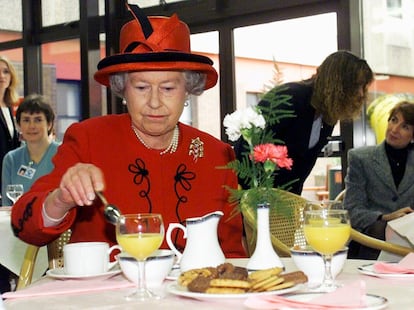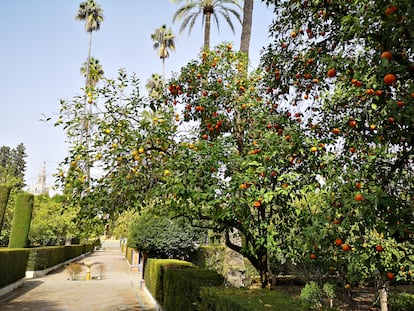Spanish palace restores lost tradition of sending Seville oranges to the queen of England
A crate of the citrus will be turned into marmalade at the residence of the British ambassador to Spain and delivered to Elizabeth II

A Spain-UK tradition that was lost in the early 20th century is making a comeback. A crate of bitter oranges from the gardens of the Real Alcázar of Seville, Europe’s oldest functioning royal residence, will be made into marmalade and sent to Buckingham Palace as a gift to Queen Elizabeth II.
The transformation from citrus into marmalade will take place inside the residence of the British ambassador to Spain, Hugh Elliot, who wrote a letter of thanks in February to Alcázar director Isabel Rodríguez.
In a handwritten note, Elliot said he is very glad that this lost tradition from the early 20th century has now been restored. The Seville oranges are “enormously appreciated” and will be turned into marmalade, “which is a blend of our cultures,” at his own residence.

Rodríguez on Wednesday explained that she was informed in late 2019 by another Alcázar official about the lost tradition of sending Seville oranges to the British royals. “Last year we got in touch with the honorary consul in Seville, Joe Cooper, and we prepared a 20-kilogram crate of oranges from our trees. He sent that via diplomatic bag to the ambassador, who had the oranges made into marmalade and sent to the queen of England.”
“This year, however, it was the consul in Seville who visited us last week to pick them up and send them to Madrid once more,” said Rodríguez, as reported by the regional daily El Diario de Sevilla.
Built in the 12th century, the Real Alcázar is surrounded by around 7,000 square meters of gardens where 1,053 orange trees and 39 lemon trees grow. This fruit gets picked by hand every year to encourage new blossoms and ensure that the city does not lose its characteristic fragrance in the spring. A specialized firm has already begun the 2021 harvest, which has been allocated a budget of €17,837.
The Real Alcázar is surrounded by around 7,000 square meters of gardens where 1,053 orange trees and 39 lemon trees grow
One of the many legends surrounding the royal residence in Seville has it that Peter of Castile (1334-1369) was the first person to plant a bitter orange tree on the premises of the Alcázar. This particular specimen is still standing near the pavilion of Charles V in the garden, and experts believe it to be the oldest of its kind in Spain. But some sources think that the tree was planted somewhat later, in the 16th century. According to these scholars, the tree was put there in March 1526, as part of the celebrations for the wedding between Emperor Charles V and Isabella of Portugal.
What is well documented is the fact that this citrus was brought to Spain in the 12th century by the Almohad caliphs who ruled Al-Andalus – as the Muslim-ruled area of the Iberian peninsula was then known – when the Alcázar was being used as a residential fortress.
All the bitter oranges that are picked each year in Seville – which amounted to 5.7 million kilograms last year, counting the trees in the Alcázar plus the more than 48,000 specimens that adorn the southern city’s parks and streets – are used for compost and cosmetics, to feed goats on industrial farms, and as fuel to make electricity. Very little of the harvest goes to the food industry because of strict quality controls.
English version by Susana Urra.
Tu suscripción se está usando en otro dispositivo
¿Quieres añadir otro usuario a tu suscripción?
Si continúas leyendo en este dispositivo, no se podrá leer en el otro.
FlechaTu suscripción se está usando en otro dispositivo y solo puedes acceder a EL PAÍS desde un dispositivo a la vez.
Si quieres compartir tu cuenta, cambia tu suscripción a la modalidad Premium, así podrás añadir otro usuario. Cada uno accederá con su propia cuenta de email, lo que os permitirá personalizar vuestra experiencia en EL PAÍS.
¿Tienes una suscripción de empresa? Accede aquí para contratar más cuentas.
En el caso de no saber quién está usando tu cuenta, te recomendamos cambiar tu contraseña aquí.
Si decides continuar compartiendo tu cuenta, este mensaje se mostrará en tu dispositivo y en el de la otra persona que está usando tu cuenta de forma indefinida, afectando a tu experiencia de lectura. Puedes consultar aquí los términos y condiciones de la suscripción digital.
More information
Últimas noticias
Welcome to the post-religion era: The idea of Christianity as the absolute truth has become obsolete
‘I thought you would like it’: The risky sexual practice popularized by TV shows and TikTok
The digitalization of tourism: ‘They promise experiences and gave us the worst possible one’
Mexican peso defies uncertainty with forecasts of a new period of stability in 2026
Most viewed
- Sinaloa Cartel war is taking its toll on Los Chapitos
- Oona Chaplin: ‘I told James Cameron that I was living in a treehouse and starting a permaculture project with a friend’
- Reinhard Genzel, Nobel laureate in physics: ‘One-minute videos will never give you the truth’
- Why the price of coffee has skyrocketed: from Brazilian plantations to specialty coffee houses
- Silver prices are going crazy: This is what’s fueling the rally










































